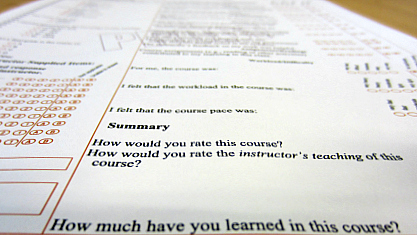
The end of semester evaluation tool filled out by Wayne State students received a significant overhaul this fall, and students will soon be able to see the results for themselves.
After more than a year of review and revision, an updated Student Evaluation of Teaching (SET) instrument was used at the end of the fall semester. Nineteen of the SET’s 22 questions were revised to better gauge student satisfaction, as opposed to coursework comprehension. Heeding a call from the students, the results will be available online.
“Faculty get to give students feedback on progress,” said Matthew Ouellett, associate provost and director of the Office for Teaching and Learning. “This is the bookend to that process.”
The Student Senate requested that SET results be posted online — where students register for classes — and the data is expected to be there in August.
It’s hoped that the release of SET data will lead to higher and more complete student participation in the evaluation process, resulting in additional information for students to select future courses. More results also ensure a sufficient sample size for faculty to ensure the results are representative of the class.
“If we don’t know how our students are doing in a course, and what they find more or less useful in learning, it is too easy to be mistaken about the quality of our instruction,” said Rita Casey, associate professor of psychology.
Timothy Spannaus, senior lecturer and program coordinator of the Instructional Technology Program, says he has made course changes after reviewing SET results.
“I cut out most of my lecturing and moved to more active learning,” said Spannaus. “I facilitate discussions and listen more than I talk. There is much more peer review, as students share their work with each other in addition to submitting it to me.”
The SET is also a great way for students to provide positive feedback to faculty about what is working well.
“Positive feedback is always welcome,” said Lawrence Lemke, associate professor of geology. “Not only does it validate my efforts as an instructor, but it also motivates me to continue to improve the methods I employ to facilitate learning in my classes.”
Given the valuable information the SET provides to both students and faculty, faculty are encouraged to take care in how they implement it.
“At the beginning of each semester, I walk through my syllabus with my class,” said Lemke. “An important part of this process is to explain the specific learning outcomes that my course is designed to achieve. At the end of each semester, immediately prior to distributing the SET forms, I return to the syllabus and remind my students of the specific learning objectives for the course they have just completed. This provides them with an objective framework from which to evaluate the course, my teaching and their learning throughout the semester. As a consequence, I believe I receive more meaningful SET feedback from my students.”
Faculty members are also encouraged to administer mid-term evaluations.
“This is a really good way to correct a growing problem, or get feedback on a new technique you may want to try,” said Margaret Smoller, interim associate dean for academic and financial affairs. “It has the added benefit of letting the students know you care about their input, which makes it more likely that they’ll participate in the SET at the end of the course.”
The Office of Teaching and Learning can assist faculty in administering the confidential evaluation tools at no cost.
The committee that revised the SET was appointed in equal parts by the provost’s office and the AAUP, and included a Student Senate representative.
